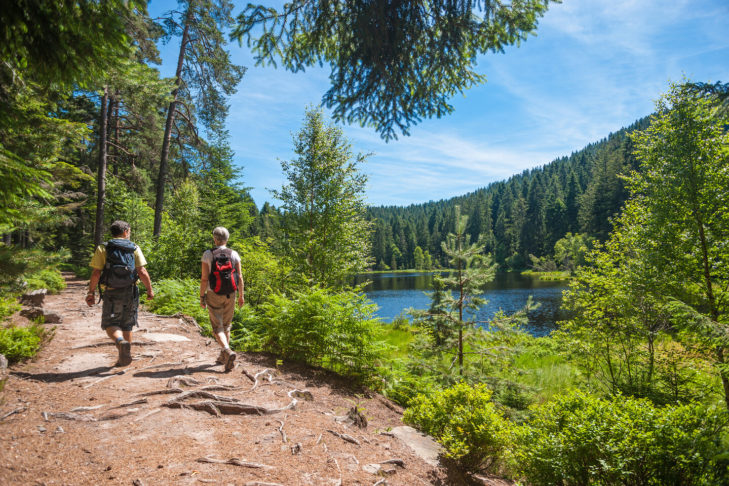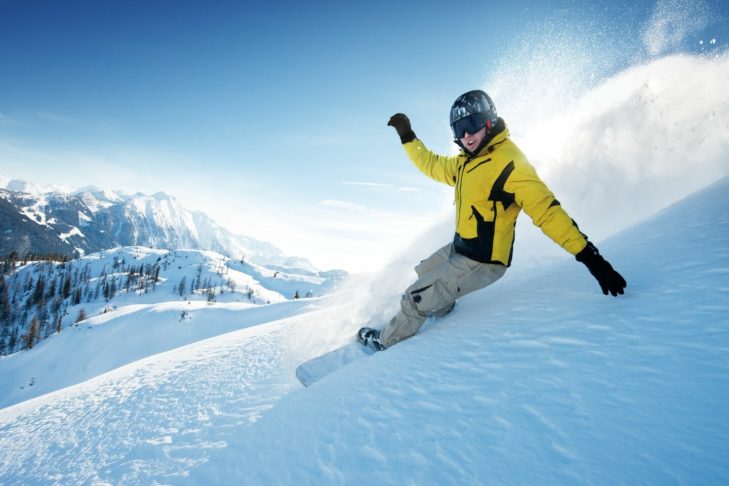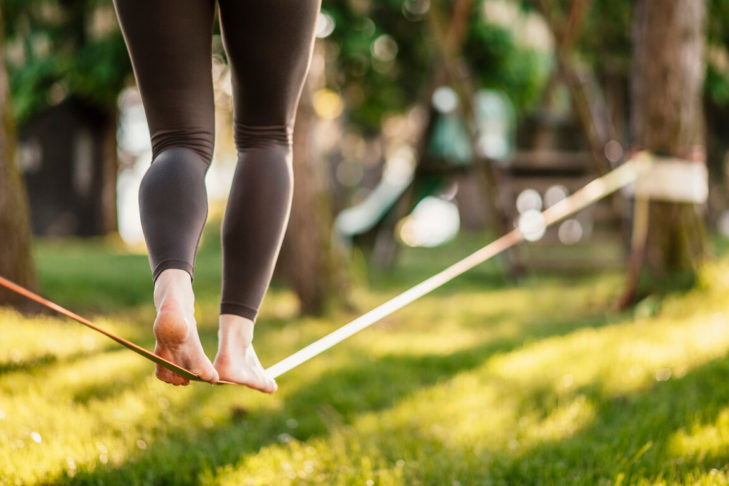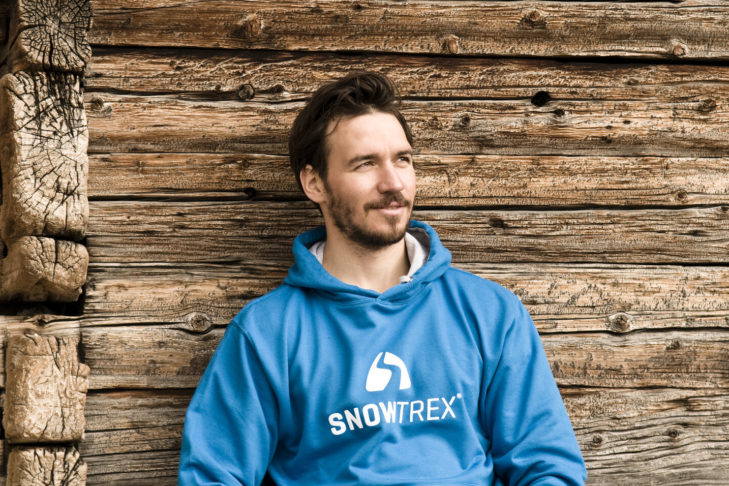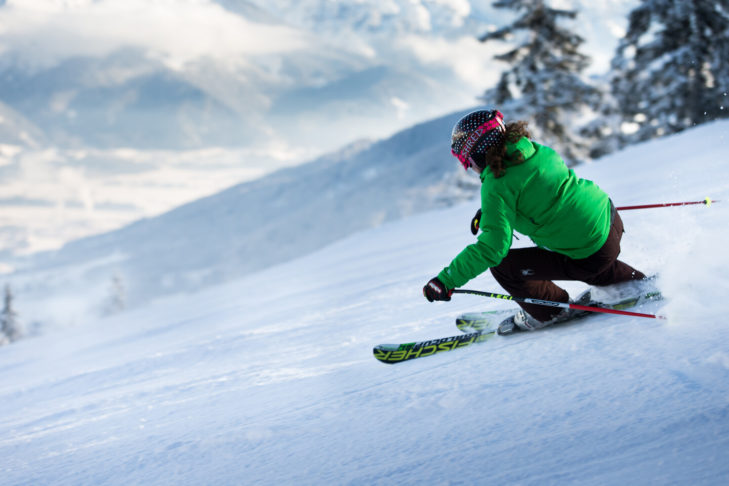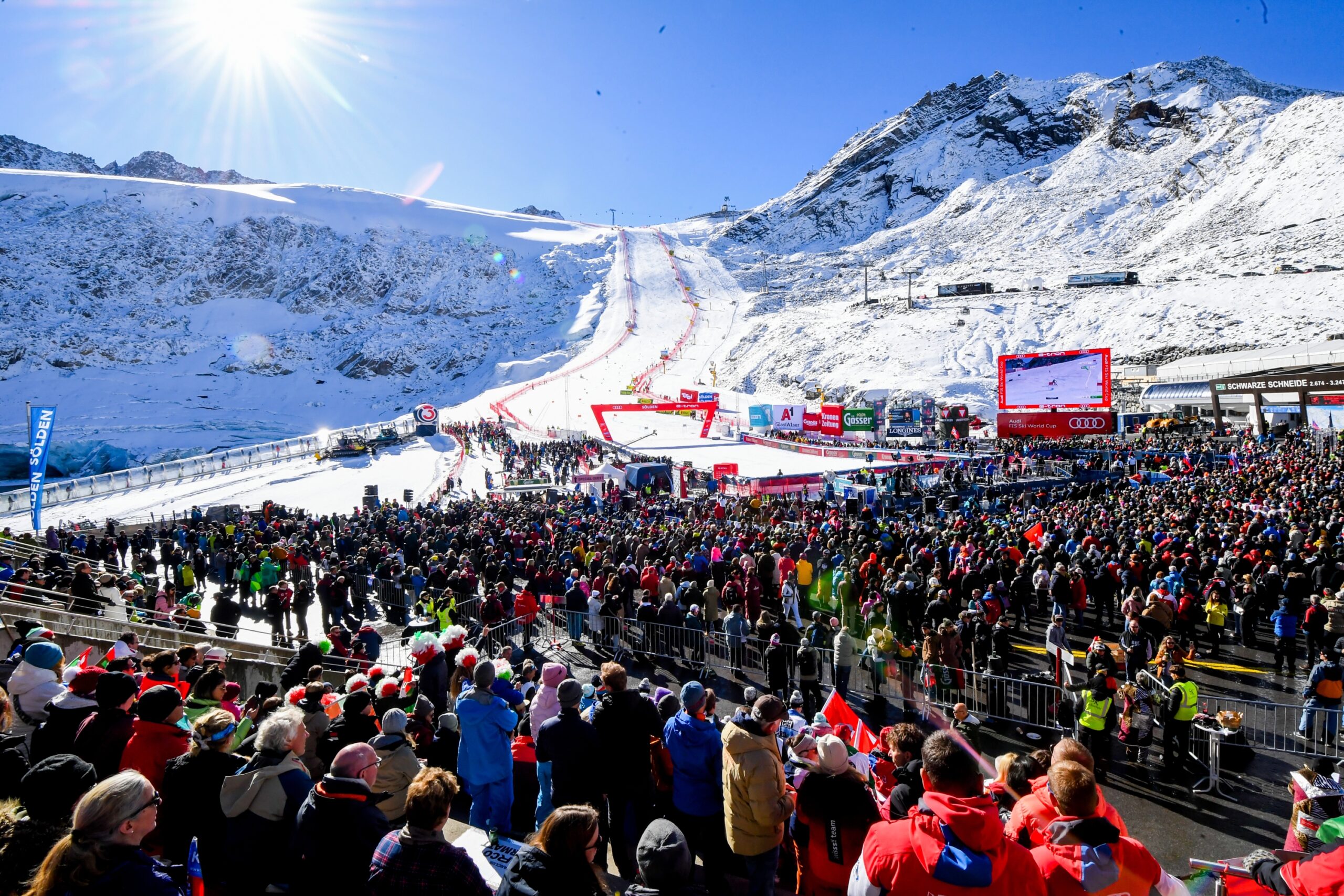If you keep fit in summer, you will enjoy winter sports even more in winter. The experts at DSV Aktiv have developed a sport-specific 3-phase fitness plan that prepares you for skiing. Phase 1: Gain basic endurance and fitness. Phase 2: Improve your strength and coordination. And phase 3: Optimise strength endurance and coordination. To this end, ski expert Felix Neureuther gives appropriate fitness tips. Here is the “Fit for winter” fitness plan in detail – so everyone can get fit for winter!
Phase 1: Basic endurance & fitness
The fitness requirements for skiers are as varied as skiing itself. Those who train extensively in summer can utilise their days in the snow even more intensively. No more burning thighs or breathlessness on the mountain! If you are physically fit, the day’s skiing will ultimately be even more enjoyable, and physical fitness also prevents injuries. Comprehensive preparation for winter sports is therefore advisable in any case, whether you are a professional or a recreational skier. In mild temperatures and sunny weather, sport is great fun anyway.
Create a foundation
At the beginning of pre-season preparation, the focus is on building up basic endurance and fitness. Endurance training not only makes the cardiovascular system more efficient, but also makes the supply of energy in the muscles more efficient and thus creates the basis for training strength and strength endurance. Basic endurance therefore creates the foundation for a fit body, which can then be intensively trained.
Phase 1 runs for 8 weeks
The “Fit for Winter” fitness plan is divided into three training phases and comprises two to three sessions per week. In the first phase, basic endurance and general coordination are trained in order to then deepen these and gain strength. Endurance is primarily boosted by sports such as cycling, inline skating, running or Nordic walking. The programme starts with simple exercise units every two days. It is important to systematically increase the load alternating with recovery phases in order to achieve so-called supercompensation. Only those who recover sufficiently after a training session can increase their performance in the long term. It doesn’t matter on which day of the week the individual units are scheduled. The main thing is that the sequence and breaks are adhered to. This also means that missed sessions do not have to be made up for. It is better to take a break and then start the training session again from the beginning. Assuming a regular rhythm, the units are organised as follows:
Weeks 1 to 3: Basic endurance
The cardiovascular system should be slowly acclimatised to physical exertion. During this training phase, the DSV Active experts recommend three sessions a week on a mountain bike or Nordic walking, hiking or easy, low-intensity running. Only at the end of the third week should a few more intensive units be added to the fitness plan.
Example plan:
| Day | Exercise |
|---|---|
| Monday | Break |
| Tuesday | Mountain biking, inline skating, hiking or Nordic walking, 60-90 minutes, low intensity |
| Wednesday | Break |
| Thursday | Mountain biking, inline skating, hiking or Nordic walking, 60-90 minutes, low intensity |
| Friday | Break |
| Saturday | Mountain biking, inline skating, hiking or Nordic walking, 60-90 minutes, low intensity |
| Sunday | Break |
Week 4 to 6: Regeneration and increasing intensity
In the fourth week, the training intensity should be kept at a low level again. To slowly acclimatise the musculoskeletal system to the increased load, running should now also be integrated into the fitness plan. In the fifth week, two units with intervals are on the programme again, before training at a low intensity again in the sixth week.
Example plan:
| Day | Exercise |
|---|---|
| Monday | Break |
| Tuesday | Mountain biking, inline skating or Nordic walking, 60-90 minutes, low intensity; from the fifth week: 60 minutes of mountain biking or inline skating, whereby a five-minute interval with a slightly higher intensity should be incorporated six times, i.e.: pedalling at full throttle for five minutes, then cycling at a relaxed pace for five minutes, then five minutes at full throttle again, etc. |
| Wednesday | Break |
| Thursday | Mountain bike inline skating or Nordic walking, 60-90 minutes, low intensity; from week 5, 60 minutes of mountain biking or inline skating in the same way as the Tuesday session |
| Friday | Break |
| Saturday | Running, 45-60 minutes, low intensity |
| Sunday | Break |
Weeks 7 and 8: Alternation of intensive and regenerative units
In the seventh and eighth weeks, two running sessions are on the programme. At the weekend, however, the intensity should be increased again with intervals in the fitness plan.
Example plan:
| Day | Exercise |
|---|---|
| Monday | Break |
| Tuesday | Mountain biking, inline skating, hiking or Nordic walking, 60-90 minutes, low intensity |
| Wednesday | Break |
| Thursday | Running, 45-60 minutes, low intensity |
| Friday | Break |
| Saturday | Running, 60 minutes, five minutes faster, then five minutes normal, five times in total |
| Sunday | Break |
Felix Neureuther’s fitness tip for basic endurance
“Endurance is the most important of all sports motor skills. This is just as true for competitive athletes as it is for the average person. […] I like cycling and it suits me. If I could choose, I would always go for my mountain bike first.” Felix Neureuther recommends cycling up to three times a week, depending on the time of year.
Phase 2: Strength & coordination
After having honed endurance and fitness in the first eight weeks, the second training phase of the fitness plan is all about refining the strength and coordination required for skiing. The main focus here is on improving sport-specific coordination skills. Anyone who thinks that this is the end of running and cycling is mistaken. Strength exercises and ski gymnastics are also important aspects of getting fit for the winter. They are integrated into the existing programme and are therefore continued in addition to the workload.
Alpine skiing, snowboarding and cross-country skiing are complex movements that use almost all muscle groups. In addition to the leg muscles, the core muscles also play a decisive role in stabilisation. It is therefore important to specifically train these areas of the body in order to be really fit for the winter.
Don’t forget your warm-up
As with any sport, strength training also requires you to warm up properly before the actual activity. Ten minutes of running, cycling, aerobics, inline skating or walking are recommended. Everyone can do what they like best. This gets the body up to working temperature and stimulates the metabolism. The muscle groups then need to be activated. Light, dynamic stretching helps to increase muscle tone, i.e. the tension in the muscle groups. But be careful: static stretching is rather unfavourable, as the muscle fibres are pulled apart and the ability to develop explosive strength quickly is reduced.
Important: Train coordination first, then strength! Muscle tone is greatly increased after strength training, which can temporarily impair fine motor skills. For this reason, strength training should always take place after coordination training.
Coordinative exercises
To be fully fit for winter, coordination skills also need to be trained, and there are many sporting options for this. Inline skating through a slalom course is an effective and fun way to do this. Mastering this course without making mistakes trains balance, rhythmisation and conversion skills. Coupling skills are also required when several tasks have to be completed simultaneously and preferably asynchronously. A very effective exercise for this would be, for example, balancing on unstable surfaces, such as a foam rubber cushion, combined with movements such as the downhill squat. Bending your knees and standing on one leg can vary this exercise efficiently. If you have mastered this, you can also try throwing an object up with one hand and catching it again. This sharpens these connections immensely. A round on the slackline is also recommended as an outdoor exercise in good weather. This wobbly line is ideal for simple to complex balance exercises.
Also not to be neglected are the motor skills that favour quick reactions. These motor reaction skills are trained through rapidly changing sequences of movements that take place in response to an acoustic or visual signal. In general, the more varied the tasks, the more complex the neural networks develop.
Not all strength is the same
Muscles can exert different amounts of force. Maximum strength is the highest possible force that can be generated during voluntary contraction. There is also speed strength, reactive strength and strength endurance. In skiing, all of these forces occur as mixed forms. Phase 2 of training initially focuses on building maximum strength, which has a positive effect on speed and reactive strength. Intramuscular coordination strength training (IC training) is particularly important here, as it aims to optimise fine control within the muscle. The explosive use of force also improves the contraction speed of the muscles, i.e. faster movements with more effort.
Legs, trunk, upper body
The DSV experts suggest several exercises for the three most important areas of the musculoskeletal system: Legs, trunk and the arm-shoulder area. The list of exercises may look long at first, but they are all small exercises that are very easy to do without the need for large equipment, so these “Fit for Winter” exercises can be easily incorporated into any fitness plan. You should plan two to three sessions per week, with sufficient regeneration phases of 48 hours in between. The intensity of the exercises must be gradually adapted to the increase in strength. This can be done by increasing the number of repetitions, increasing the intensity or adding additional training sessions.
SnowTrex presents some strengthening exercises below.
Exercises to strengthen the leg muscles
Exercise 1: Squats
Variations: Squats with explosive jump (high intensity); one-legged squats (high intensity), possibly with additional weight; squats in step position; squats in step position with jump (high intensity).
Important: The heel remains on the floor, the knees must not rotate inwards and should ideally be pushed slightly outwards, knees and toes should be in line. In healthy athletes, the knee does not always have to remain vertically above the foot as long as the heel remains on the ground. The key to a back-friendly exercise is to maintain the curvature of the spine in the lumbar region throughout the entire exercise (straight back, slightly hollow back).
Exercise 2: Squat jumps on the spot
Variations: over obstacles; on higher obstacles (higher intensity)
Exercise 3: One-legged jumps
Variations: over obstacles (higher intensity)
Exercise 4: Standing up on one leg from a bench
Variation: single-leg stand-up on a bench – the higher the bench, the higher the intensity
Exercise 5: Push up on tiptoes
Variation: one-legged push-up on tiptoes
Exercise 6: Short sprints
Variation: Running up and down stairs with an explosive push-off
Exercise 7: Downhill squat on unstable surfaces (soft floor, trampoline, wobble board)
Variation: Rocking with weight shift from right to left
Exercises to strengthen the core muscles
Exercise 1: Raising the extremities from a prone position
Variations: Paddling (arms and legs move up and down); alternate lifting (right arm and left leg simultaneously and vice versa), the head is in extension of the spine
Exercise 2: Diagonal raising of the extremities from a quadruped position
Variation: rocking movements
Exercise 3: Forearm support
Variations: Lift legs alternately (higher intensity); diagonal lifting of the extremities, lateral support with and without lifted leg
Exercise 4: Crunches (sit-up alternative)
Please also note that by using our services and integrating the YouTube API Services, the YouTube Terms of Service and the YouTube API Services Terms apply and your use of our website is deemed to be acceptance of these terms.
Variations: frontal; sideways to the bent knee; fast/slow; with long hold times; with additional weights
Exercises to strengthen the upper body muscles
Exercise 1: Push-ups
Variations: on knees (lower intensity); arms raised (lower intensity); legs raised (higher intensity); fingertips inwards – elbows outwards; fingertips forwards – elbows on body
Exercise 2: Back tricep presses on chair or bench (dips)
Variation: one leg is stretched forwards while bending the arms, dips on the parallel bars (higher intensity)
Exercise 3: Pull-ups
Variations: With Theraband (lower intensity), from a standing position (lower intensity), chin-ups (palms turned towards the body)
Felix Neureuther’s fitness tip for building strength
“If you’re a bit flexible, you can be very versatile with your strength training. If it’s not raining, I go out into the countryside for strength training. I think push-ups backwards on the spectator steps in the ski stadium in Garmisch-Partenkirchen are great. Taking one step at a time up the stairs with your feet backwards and looking towards the blades of grass is incredibly good for your whole body and also for your head.”
Phase 3: Strength endurance & coordination
After several weeks of training with the fitness plan, you can finally feel the change and feel more and more fit for the winter. Your condition improves and your muscles become stronger. The solid foundation was laid in the first phase and the strength training from the second phase is having an effect. Phase 3 is now about training your sport-specific strength endurance.
Strength endurance is the magic word
Burning thighs on the piste, over-acidified muscles on the cross-country ski run – all part and parcel of ambitious skiing. Systematic preparation minimises these signs of fatigue and delays the onset of fatigue as much as possible. We achieve this goal with strength endurance. It is intensively strengthened in our third training phase. The level of strength endurance varies depending on the sport and discipline. For example, a downhill specialist who exerts great force over a relatively short period of time requires a different form of strength endurance than a cross-country skier who competes in a 50-kilometre race where only low or medium forces are exerted over a very long period of time. Strength intensity as a function of stimulus duration is therefore a decisive criterion for strength endurance.
Excursion into the muscle interior
Strength endurance training is about adapting and optimising the metabolic processes in the muscle to the load. Stimulus intensity and stimulus volume influence the supply of energy in the muscle. A distinction is made between aerobic and anaerobic training. During aerobic training, the muscles have an excess of oxygen, less blood is pumped into the arteries and the pulse and blood pressure are lower than during anaerobic training. Aerobic training stimulates the cardiovascular system and can be carried out over a longer period of time, e.g. jogging or cycling. With anaerobic training, it is the other way round: the muscles are used briefly but intensively and burn energy without the help of oxygen. A classic form of anaerobic training is strength training on machines. Depending on the intensity, strength endurance training has more or less aerobic and anaerobic metabolic components. In practice, it is therefore important to set the right training stimuli according to the sport-specific load.
In addition to optimising the metabolism, strength endurance training also aims to improve the interaction between the muscles involved. This reduces the effort required, the energy requirement decreases and the muscles do not tire as quickly. Training that only aims to improve coordination between the muscles must be correspondingly close to the actual sequence of movements. The exercises mentioned here are aimed more at optimising the metabolism, although aspects of muscle coordination are also taken into account.
Specialised strength endurance for alpine skiers
In alpine disciplines, strength endurance training should tend towards higher intensities and shorter durations. In other words, great effort, but only for a few seconds. Four to seven sets are trained with a shorter stimulus duration at 20 to 50 per cent of maximum strength. The exercises can be dynamic and static, with loads in the aerobic and anaerobic range. Additional weights that are easy to integrate into the “Fit for Winter” fitness plan include weight cuffs, small dumbbells, sandbags, medicine balls, stones or similar items that weigh no more than 1 to 5 kg, depending on maximum strength.
Exercises to increase the strength endurance of the leg muscles
Exercise 1: Squat jumps
from the half-deep squat to the stretch jump, 20-25 repetitions, divided into several sets
Exercise 2: Jumping rope
without intermediate jumps, 40-60 seconds
Exercise 3: Squats
with additional weights, 15-20 repetitions, divided into several sets
Exercise 4: Knee lifts
uphill, 30-40 seconds
Exercise 5: High knee skips
with small additional weights and active push-off of the jumping leg, the arms are moved in opposite directions, 20-30 repetitions per leg, divided into several sets
Specialised strength endurance for cross-country skiers and biathletes
For cross-country skiers and biathletes, the aim is to withstand stress over a long period of time. The exercises for strength endurance training should be performed at around five to 20 per cent of maximum strength. Furthermore, the training is characterised by a large number of repetitions and a long stimulus duration. The exercises are dynamic and characterised by a more aerobic energy metabolism. Three to five sets are trained. During intensive training sessions, the exercises can also be pushed to the maximum number of repetitions.
Exercises to increase the strength endurance of the leg muscles
Exercise 1: Squats
without additional weights, 30-50 repetitions, divided into several sets
Exercise 2: Knee lifts
on the spot, at least 40 seconds
Exercise 3: Walking in lunges
right and left 20-40 repetitions each, divided into several sets
Exercise 4: High knee skips
30-50 repetitions per leg, divided into several sets
Exercises to increase the strength endurance of the core muscles
Exercise 1: Spider walk / Crab walk
Belly pointing upwards, arms almost straight, legs bent, feet on the floor, hips largely stretched out; moving forwards and backwards, 40-60 seconds
Exercise 2: Neck bridge
Neck and feet are on the floor, hips are moved up and down; 20-30 repetitions; split into several sets
Exercises to increase the strength endurance of the muscles of the upper extremities
Exercise 1: Push-ups against the wall
30-40 repetitions, divided into several sets.
Exercise 2: Imitation exercise
Arm movement as in the double pole exercise with small additional weights, 40-60 repetitions, divided into several sets
Exercise 3: Pull-up from a standing position or with Thera-Band
20-30 repetitions, divided into several sets
Circuit training with the group
Circuit training is suitable for groups who want to train their strength endurance together and get fit for the winter. Depending on the type of sport and intensity of the exercises, the time spent at the individual stations is between 30 and 60 seconds or at least 20 repetitions at a medium speed of movement. The stations are set up so that the muscle groups are trained in alternating sequence. For recreational athletes, the break between the stations is 1:1 in relation to the working time; for high-performance athletes, the break is somewhat shorter. Strength endurance circuits, on the other hand, use the maximum repetition method.


